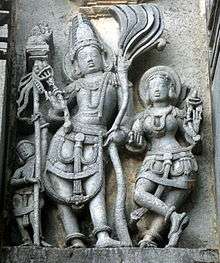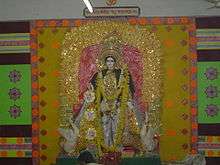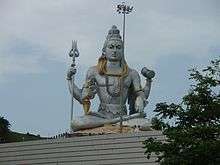Vasant Panchami
| Vasant Panchami | |
|---|---|
 Festivals of Spring | |
| Official name | Vasant Panchami |
| Also called |
|
| Observed by |
|
| Liturgical Color | Yellow |
| Observances | Puja and social functions |
| Date | Magha Shukla Panchami |
| 2015 date | 24 January |
| 2016 date | 12 February [1] |
'Vasant Panchami' (also called Basant Panchami) refers to the following festivals: the religious Hindu festival of Saraswati Puja also called Shree Panchami; Sufi Basant observed in Sufi shrines; the seasonal spring festival of Vasant Panchami observed in many regions; the Basant Festival of Kites of the Punjab region; observance in Gurdwaras as a Sikh festival; the birthday of the Deo-Sun God in Bihar and a harvest festival. The festivals are celebrated on the fifth day of Magha.
Etymology
Vasant Panchami has a specific meaning: Vasant means "spring,"and Panchami means "the fifth day." Vasant Panchami falls on the fifth day of spring.
The festival is observed in the northern part of the Subcontinent. Although it is notified in the ritual calendar of South India, it is not celebrated as a household or public event but in temples as a religious festival.The same rings true of the central region of Madhya Pradesh.
Date
Vasant Panchami is celebrated every year on the fifth day of the bright half of the Indian month of Magha .
Religious festival
Hinduism
Kamadeva and Rati

In ancient Indian literature, Vasant Panchami is associated with Shringara Rasam and the festival was celebrated in this tradition.[2] Celebrations today still honor Kamadeva, his wife Rati, and his friend Vasant (the personification of Spring).[3]
During the ancient period when Vasant Panchami was more oriented toward Kamadeva, dancing girls, dhol players, and other celebrants would come to the royal Bakshi's palace to create an informal durbar with the royals. Specially made Vasanti clothes would be worn by the dancing girls and younger royal ladies, consisting of a skirt, blouse, and pink or saffron sari with tiny red square or circular dots. This clothing would be further embellished with gold and silver borders and brocade work. On the celebration day the dancing girls would collect flowers and mango leaves from the garden of the Bakshi's palace. The flowers and mangoes were arranged in brass vessels and the informal durbar would be set up. The occasion was marked by the singing of various ragas usually on the theme of love (especially songs involving Krishna and Radha or the gopies of Brij Bhoomi). At the conclusion of the celebration, the flowers would be sprinkled with red gulal and the dancing girls would apply it to their cheeks. They were then gifted a sum of money by the royal ladies. Today this is not practiced, and the festival is oriented toward Sarasvati, however Kamadeva remains an important figure as feasts are held in his honor during Vasant Panchami,and the theme of love remains an important part of the festival with this being the most popular day of the year for weddings in some areas.[4]
Vasant and Holi
Vasant Panchami is the first and more minor of two spring-themed festivals in Hindu culture. Vasant Panchami initiates the spring festive cycle and heralds its summation that occurs with Holi.The 40-day period between Vasant Panchami and Holi corresponds with the 40 days of Rati's penance after her husband, Kamadeva was reduced to ashes for shooting the eye of Shiva with his love arrows. Between Vasant Panchami and Holi, preparations are made for numerous burnings in effigy of the demoness Holika. Starting on Vasant Panchami, a log with a figure of Holika is placed in a public place and during the next 40 days, the faithful add twigs and other combustible material to the log to form a pyre which is lit on Holi.
In places such as Balarama temple in Baithain, the singing of Holi songs and the throwing of color begin on Vasant Panchami and continue throughout the Holi season.
Goddess Saraswati
Goddess Saraswati is the goddess of learning, wisdom, knowledge, fine arts, refinement, science and technology. Vasant Panchami is treated by celebrants as Saraswati's birthday.People worship Goddess Saraswati to attain enlightenment through knowledge and to rid themselves of lethargy, sluggishness and ignorance.
The story of Saraswati Puja is related to the Brahma Vaivarta Purana. Sri Krishna granted Saraswati a boon that she too will be worshipped on Vasant Panchami. After performing morning ablutions and bathing, a Kalasha is established. After worshipping Ganesh, the Sun, Vishnu and Shiva, Saraswati is worshipped. Thereafter, coloured powder is thrown into the air.This is the general form of observance of praying to Goddess Saraswati on Vasant Panchami. In places such as Uttar Pradesh, prayers are offered to Goddess Saraswati and people sing religious verses to celebrate the festival. Interestingly, in Tamil Nadu and South India Saraswati is worshipped on the ninth day of navratri in the month of ashwin.
Saraswati Puja
In NepalBihar and eastern India, a distinct festival in honour of Saraswati is celebrated. The festival is known as Saraswati Puja in eastern parts of India, and as Sri Panchami in parts of Andhra pradesh Bengal.[3][5] In Bengal and eastern India, the primary focus of the day is to honour Saraswati.[6]
Traditions of Saraswati Puja

The day before Vasant Panchami in Nepal, Saraswati's temples are filled with food so that she can join the celebrants in the traditional feasting the following morning.[4] In temples and educational institutions, statues of Saraswati are dressed in yellow and worshiped.[4] Most educational institutions arrange special prayers or pujas in the morning to seek blessing of the Goddess. Poetic and musical gatherings are held and children are initiated to learn the alphabet[3] and are often taught to write their first words.[4] This ritual of initiating education to children is known as Akshar-Abhyasam or Vidya-Arambham/Praasana, one of the famous rituals of Vasant Panchami. Older students clean their pens and inkwells but abstain from reading or writing on this day.[4] In Bengal, idols of Saraswati are taken on procession and immersed in the holy Ganga.[3]
The color yellow plays an important role in Vasant Panchami as it is related to the bloom of mustard flowers during this period.[7] Celebrants usually wear yellow garments,[3] Saraswati is worshiped in a yellow dress,[4] and sweet saffron rice[3] and yellow sweets are consumed within the families.[4]
National Festival

Even though in many parts of India, Vasant is observed as a secular seasonal holiday, the Indian government is encouraging the observance of Saraswati Puja in educational institutions.[8] Directives have been issued in Gujarat and Rajasthan to promote the festival where it is traditionally observed as a seasonal festival.[9][10]
Saraswati Puja is a "great day to inaugurate training institutes and new schools – a trend made famous by the renowned Indian educationist Pandit Madan Mohan Malaviya (1861-1946), who founded the Banaras Hindu University on Vasant Panchami day in 1916."[11]
Accordingly, Saraswati Puja has grown in popularity in recent years and is associated with schools generally.[12] The festival is fast becoming or indeed has become a pan North Indian festival.
Overseas Celebrations
The festival is celebrated by the Indian diaspora based at Nottingham, UK, every year under the aegis of the socio-cultural group Jhankar-NICA.[13]
Lord Shiva

Vasant Panchami is also associated with Lord Shiva. On this day people pray to Lord Shiva or to the family God. Wearing yellow is not universally observed.[14]
Traditionally, in Maharashtra. Madhya Pradesh, Chhattisgarh and Uttar Pradesh, after bathing in the morning, people worship Lord Shiva and Goddess Parvati. Offerings of mango flowers and the ears of wheat are traditionally made.[15]
Lord Vishnu
People apply sesame paste to their bodies and then bathe. Thereafter, people wear yellow clothes and pray to Lord Vishnu. The Brahmin should be invited to join in the lunch feast, and perform ancestor worship (Pitr-tarpan). Once this is done coloured powder is applied and thrown into the air.[16]
Sun-Deo God
The shrine of the Sun-God in Aurangabad district, Bihar known as the Deo-Sun Shrine, was established on Basant Panchami. The day is celebrated to commemorate the founding of the shrine by King Aila of Allahabad and the birthday of the Sun-Deo God. The old clothes of the Sun God are replaced, the shrine is washed and people participate by singing.[17]
Sufi Basant

Muslims have been celebrating Basant since the 12th century A.D. According to legend Delhi's Chishti Saint Nizamuddin Aulia's young nephew Taqiuddin Nooh died. Stricken with grief, he withdrew from society. The court poet, Amir Khusrau, tried to think of ways to brighten the Saint's mood. Upon seeing local women carrying flowers on Basant and dressed in yellow, Khusrau too dressed in yellow and took flowers to the Saint. This brought a smile on the Saint's face. Since then, Basant has been celebrated at the dargah of Nizamuddin Aulia in Delhi and all dargah's of the Chishti order.[18]
Sikhism
Six seasons are mentioned in the Guru Granth Sahib which determine the style used to sing verses.[19][20]
For Sikhs, in the Harmandir Sahib, Amritsar, on the day of Vasant Panchmi, musicians start the music by singing Basant Raga. This practice continues up until the first day of Vaisakh when Basant Rag is no longer used.[21] A fair is normally held at the famous Sikh shrine of Guru-ka-Lahore in Bilaspur district to mark the occasion of the marriage of Guru Gobind Singh Ji on Vasant Panchami.
Maharaja Ranjit Singh encouraged the celebration of Basant in the Gurdwara. In 1825 A.D. he gave 2,000 rupees to the Harmandir Sahib Gurdwara in Amritsar to distribute food.[22]
Seasonal festival
The seasonal aspects of the festival are more significant in Northern India due to the sharper contrast between the winter and the spring.[7] People celebrate the day by wearing yellow, eating sweet dishes and display yellow flowers in homes. In Rajasthan, it is customary for people to wear jasmine garlands.[10]
-

yellow themed festival
Harvest
In Uttarakhand, in addition to Saraswati Puja, people worship the mother earth and the crops or agriculture. Worship involves people placing cowdung heaps in the fields, and keep ears of barley and wheat on the heaps. Earthen lamps and incense are lit on the heap to signify worship to the mother god and the crops or agriculture. Ears of corn and barley are also tied to doors and windows of buildings. People eat sweet rice and wear yellow.[23] In Gujarat, women perform the dandya dance on Vasant Panchami which is a dance associated with harvesting, reaping and sowing.[24] In Bihar[25] and Bengal, people worship the plough linking the festival to a harvest ritual.[26]
-
_p038_THE_COUNTRY_PLOUGH.jpg)
GRIERSON(1885) p038 THE COUNTRY PLOUGH
Basant Festival of Kites
In the Punjab region, Basant is celebrated as a seasonal festival by all faiths and is known as the Basant Festival of Kites. Maharaja Ranjit Singh introduced the tradition of kite flying on Basant over two hundred years ago, which became popular in the Punjab region.[27] Kite festivals are held in cities such as Firozpur,[7] where children generally fly kites to mark the auspicious occasion. This has led to the festival being called the Festival of Kites or the Kite Festival.[7] Children buy Dor (Thread) and Guddi or "Patang" (Kites) in huge quantities to fly overhead. This attracts tourism from around the world.
References
- ↑ Office Holidays
- ↑ Dilipsinh, K. S. "Ch.8 - The Festival of Spring" from Kutch: In Festival And Custom. Har-Anand Publications. Pg.98. 2004. ISBN 9788124109984
- 1 2 3 4 5 6 Vema, Manish. Fast and Festivals of India. Diamond Pocket Books. Pg.72. 2000. ISBN 9788171820764
- 1 2 3 4 5 6 7 Roy, Christian. Traditional Festivals: A Multicultural Encyclopedia. ABC-CLIO. Vol.2. Pp.192-193. 2005. ISBN 9781576070895
- ↑ Swami Mukundananda (2015) Festivals of India
- ↑ Dibakar Purkayastha (2015) LOG OUT! NORTH-EAST INDIA: AN UNTOLD STORY OF REVERSE RACIS
- 1 2 3 4 Knapp, Stephen. "The Dharmic Festivals" from The Power of the Dharma: An Introduction to Hinduism and Vedic Culture. iUniverse. Pg.94. 2006. ISBN 9780595837489
- ↑ Mukul Kumar Mishra (24.01.2015) Gujarat: Circular to hold 'Saraswati Vandana' stirs controversy; Muslims express displeasure
- ↑ Rajasthan [district Gazetteers].: Jaipur
- 1 2 Journal of the Indian Anthropological Society, Volume 30 (1995)
- ↑ "Vasant Panchami: Birthday of Goddess Saraswati". Hinduism.about.com. 2014-02-13. Retrieved 2014-02-17.
- ↑ Chaise LaDousa Hindi Is Our Ground, English Is Our Sky: Education, Language, and Social Class in Contemporary India
- ↑ http://www.jhankarnica.weebly.com
- ↑ N. Jayapalan (2001) Indian Society and Social Institutions
- ↑ R. Manohar Lall. Among the Hindus: A Study of Hindu Festivals (1933)
- ↑ Dr. Bhojraj Dwivedi (2006)
- ↑ Anirudha Behari Saran, Gaya Pandey (1992) Sun Worship in India: A Study of Deo Sun-Shrine
- ↑ Chishtism. Sufi Basant at Chishti Dargah
- ↑ Surindar Singh Kohli (1992) A Conceptual Encyclopaedia of Guru Granth Sahib
- ↑ Nikky-Guninder Kaur Singh (2011) Sikhism: An Introduction
- ↑ Dr Kirpal SIngh
- ↑ Hari Ram Gupta (1991) History of the Sikhs: The Sikh lion of Lahore, Maharaja Ranjit Singh, 1799-1839
- ↑ Sharad Singh Negi (1996)Uttarakhand: Land and People
- ↑ Encyclopaedia of Hinduism (1999)
- ↑ Pranab Chandra Roy Choudhury (1976) Folklore of Bihar
- ↑ Ramchandran, Shivani. Bharatiya Jayantiyan Evam Tyohar. Shrikrishna Pustak Bhandar. ISBN 9788188514441
- ↑ Camille Mirepoix (1967) Now Pakistan
- "Vasant Panchmi", a book by Anurag Basu.
- "Kite Festival" by Sanjeev Narula.
| |||||||||||||||||||||||||

